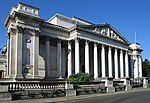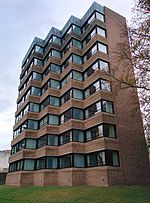Cambridge Poetry Festival
The Cambridge Poetry Festival, founded by Richard Berengarten (also known as Richard Burns), was an international biennale for poetry held in Cambridge, England, between 1975–1985.The festival was founded in an attempt to combine as many aspects as possible of this form of art. Thus Michael Hamburger could, for example, recite his English interpretations of Paul Celan's poetry in the presence of Gisèle Lestrange and a surprisingly large audience at an art gallery bestowed on her engravings. The last biennale in 1985 included a number of events to mark Ezra Pound's centenary, including the exhibition Pound's Artists: Ezra Pound and the Visual Arts in London, Paris and Italy at Kettle's Yard (later also shown at the Tate Gallery) and was accompanied by a special issue of the magazine PN Review.
Excerpt from the Wikipedia article Cambridge Poetry Festival (License: CC BY-SA 3.0, Authors).Cambridge Poetry Festival
Fitzwilliam Street, Cambridge Newnham
Geographical coordinates (GPS) Address Nearby Places Show on map
Geographical coordinates (GPS)
| Latitude | Longitude |
|---|---|
| N 52.2 ° | E 0.12 ° |
Address
Fitzwilliam Museum
Fitzwilliam Street
CB2 1QH Cambridge, Newnham
England, United Kingdom
Open on Google Maps









